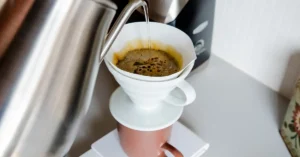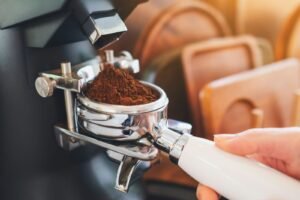Excelling at utilizing a pour-over espresso creator can essentially upgrade your espresso experience, empowering you to enjoy an impeccably blended cup without fail. The most important thing is knowing how to properly prepare, blend, and operate your espresso maker. In this guide, you will find a nitty-gritty, bit-by-bit way to deal with the guarantee every part of the cycle adds to a tasty and fulfilling mug of espresso. You will not only improve your method of preparation but also extend the life of your espresso maker if you follow these guidelines. Thus, you will partake in a reliably great espresso experience.
Definite Guidelines for Utilizing a Pour-Over Espresso Creator
Gather Your Supplies
- Pour-Over Coffee Maker: Ensure that it is clean and dry before beginning.
- Coffee Beans: For the best extraction, use freshly ground coffee beans, preferably ground to a medium coarseness.
- Filter: Choose between paper or metal filters, depending on your espresso maker.
- Water: Use clean, filtered water to keep away from impurities that could affect the flavor.
- Scale: Consider using a scale to measure your coffee and water exactly.
- Kettle: A gooseneck kettle is ideal for precise pouring management.
Boil Water
First, bring easy, filtered water to a boil. After boiling, allow the water to cool barely to attain the proper brewing temperature, that is, between 195°F and 205°F (96°C and 90°C). Making sure your espresso extract does not taste sour is the purpose of this segment.
Prepare the Coffee Maker
- Place the filter: Insert the espresso clear-out into the pour-over cone. If you’re using a paper filter, rinse it with warm water. This motion gets rid of any paper residue and preheats the espresso maker. Discard the rinse water to make certain it does not dilute your espresso.
- Add Coffee Grounds: Measure and add your espresso grounds to the clearout. Generally, use 1 to 2 tablespoons of coffee grounds in keeping with 6 oz. of water, adjusting based on your taste preference.

Pre-Wet the Grounds
Then, pre-wet the coffee grounds by putting a little hot water over them. This method, which is called blooming, improves taste absorption by allowing the espresso to discharge any trapped gases. Before continuing, let the grounds bloom for around 30 seconds.
Pour the Water
In the wake of cleaning, store your pour-over espresso producer in a dry, dust-free area. Guarantee that all parts are totally dry before putting them away to forestall mold and buildup development.
Allow the Coffee to Drip
Allow the espresso to drip into the carafe or mug below by pouring it through the clear glass. The brewing system must take approximately 2 to 4 minutes. Avoid stirring the coffee grounds or rushing the system, which will result in a sour taste and choppy extraction.
Serve and enjoy.
- Once the brewing is complete and the dripping has stopped, get rid of the filter with the used espresso grounds. Discard the grounds, and if using a reusable filter, rinse it thoroughly.
- Pour the freshly brewed espresso into your cup. Enjoy your coffee at once to relish the quality flavors and aromas.
Clean Up
After taking part in your espresso, proceed to smooth the pour-over espresso maker. Remove and discard the used filter. Rinse the cone and carafe with hot water to do away with any espresso residues. For a more thorough cleaning, use a little soap and water, making sure that all parts are completely dry before storing them.
Tips for Best Results
- Use Fresh Coffee Beans: Freshly ground espresso beans will enhance the flavor of your brew. Grind beans simply before brewing to preserve freshness.
- Regulate Water Temperature: Don’t immediately use boiling water on the espresso grinds. Allow the water to cool just enough to prevent scorching the coffee and destroying its flavor.
- Try Different Ratios: Adapt the mix of coffee to water to your preferred flavor. Continue with the general rule and adjust it before you get the cup of your dreams.
- Frequent Upkeep: To prevent the accumulation of coffee residue and oils, clean your espresso maker frequently.
- This upgrade makes sure your espresso creator will continue to produce excellent coffee and remain in excellent working order.

Conclusion
In summary, working with a pour-over coffee maker consists of an entire lot more than pouring warm water over coffee beans. You can examine how every action, from schooling to preservation, influences the pleasure of your coffee by following the specific steps in this manual. You’ll get each cup full of taste and free of unwanted residue if you carefully measure and pour, permit proper blooming, and observe an everyday cleansing habit. Your coffee makers may also last longer in case you comply with these methods, making the funding worthwhile. Begin implementing those hints in recent times, and you’ll truly experience the stepped-forward flavor and effectiveness of your pour-over coffee brewer.
FAQ’s
1. How frequently would it be a good idea for me to descale my pour-over espresso creator?
You ought to descale your pour-over espresso maker roughly every 3 to 3.5 years, contingent upon how habitually you use it and the hardness of your water. If you notice a slower preparation time or an adjustment of taste, it could be an ideal opportunity to descale.
2. Might I, at any point, utilize normal faucet water for preparing espresso?
While you can utilize customary regular water, it’s ideal to utilize filtered water to stay away from pollution and chlorine that can influence the flavor of your espresso. Separated water guarantees a cleaner and more reliable flavor.
3. How can I tell whether my espresso producer needs cleaning?
Signs that your espresso producer needs cleaning include a slower fermenting time, espresso with an off taste, or noticeable espresso buildup. Routinely investigating and keeping up with your espresso producer forestalls these issues.
4. What kind of espresso channel would it be a good idea for me to utilize?
You can utilize either paper or metal channels with your pour-over espresso producer. Paper channels are helpful and expendable, while metal channels are reusable and can give a fuller body to your espresso. Pick, given your inclination and the flavor profile you want.
5. How might I store my pour-over espresso creator?
In the wake of cleaning, store your pour-over espresso creator in a dry, dust-free area. Guarantee that all parts are totally dry before putting them away to forestall mold and buildup development.
6. Could I at any point utilize a cleanser to clean my pour-over espresso creator?
You can clean your espresso maker with a gentle cleaner. Notwithstanding, make a point to wash completely to eliminate any cleanser buildup, as it can influence the quality of your espresso.
7. What is the best water temperature for blending espresso?
The ideal water temperature for preparing espresso is somewhere in the range of 195°F to 205°F (90°C to 96°C). Water that is too hot can consume the coffee beans, while water that is too cool might bring about under-extraction.
8. How would I guarantee even extraction while preparing espresso?
To guarantee even extraction, pour the water gradually and consistently in a round movement over the espresso beans. Permit the espresso to sprout before pouring everything into the water. This procedure immerses the grounds equitably and further develops flavor extraction.
9. How would it be advisable for me to respond, assuming my espresso tastes harsh?
If your espresso tastes severe, it very well might be because of over-extraction or consumed coffee beans. To address this, have a go at changing your drudgery size to be marginally coarser, diminishing the preparation time, or guaranteeing that your water temperature isn’t excessively high.
10. Might I at any point brew tea utilizing my pour-over espresso producer?
Indeed, you can brew tea utilizing your pour-over espresso creator. Just supplant the coffee beans with free tea leaves or a tea pack and follow a comparative blending process, changing the water temperature and soaking time as per the kind of tea you are utilizing.




